|
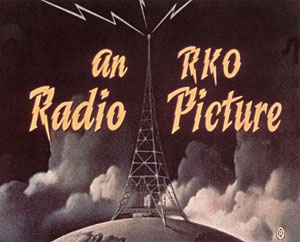 The
first immigrants to the United States began to arrive after the War
between North and South and grew to a flood in the latter part of the
last Century. The complex of
buildings on Ellis Island were purpose built to try to control that tide
of humanity and from the time of its first immigrants to the time of its
closure over twelve million souls had been processed within those walls. The
first immigrants to the United States began to arrive after the War
between North and South and grew to a flood in the latter part of the
last Century. The complex of
buildings on Ellis Island were purpose built to try to control that tide
of humanity and from the time of its first immigrants to the time of its
closure over twelve million souls had been processed within those walls.
When the immigrants finally reached the Promised Land, many found that
their circumstances were little different to the places they had left
and they gathered together for mutual comfort and protection.
Far from being The Great Melting Pot, at that time enclaves of
Poles and Irish and Italians fought between themselves and struggled to
make a place for themselves in their new world.
The greater part of them eventually made it through hard work and
imagination and a very few turned to crime as the way forward.
The
old adage that The Road to Hell is Paved with Good Intentions
was never
more true in the case of the Volstead Act when the prohibition of liquor
led to the greatest crime-wave that America had ever seen, welded the
crime-families together and George Raft, James Cagney, Paul Muni
and Edward. G. Robinson were inspired to begin a spate of crime movies which
has increased yearly to date.
At the time, gangsters were seen as glamorous figures not doing any real
harm in supplying liquor and there were many instances where film stars
and gangsters mixed socially -- until things got nasty.
The
earliest gangster films of any note were synonymous with both immigrant
populations and prohibition, and commemorating
those cataclysmic events, flourished from the 30’s onward. James Cagney, born in The Lower East Side of New York in 1899
of Irish, immigrant parentage, was familiar with both of these things
and having been brought up on the streets of New York then had every
attribute necessary to play gangster roles.
Although he made many more varied films throughout his long career and
despite the fact that most of them were made in his early days of
film-making, James Cagney will forever be associated with gangster
movies. If the staccato
delivery and the dialogue now seem a little quaint to modern ears it
must be remembered that it is all of 75 years ago that these films were
made but there is no doubt that it is the authentic argot
of the times.
The
Public 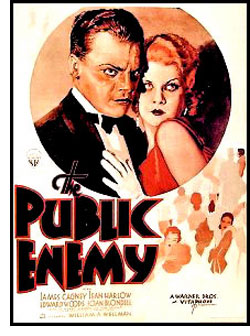 Enemy
{
1931 } Enemy
{
1931 }
Directed by William Wellman, was Cagney’s first starring role
and his rapid-fire delivery and nervous energy captivated cinema
audiences watching on-screen what they had been reading in the
newspapers and was still going on around them.
Directors were not slow to film re-enactments of actual events
and cobble them into the tale they were telling and they had few qualms
about distorting actuality to suit their own purposes.
The infamous grapefruit scene came about in this way copied from
an incident involving Hymie Weiss.
The scene has become legendary in movie folklore and several
versions are extant --- Mae Clark stated that Cagney was a true
professional and made it appear that the grapefruit hit her while
another version has it that Cagney hit her so unexpectedly and painfully
that her surprise and shock were not feigned.
So. you pays your money ……. as the saying goes.
Whatever the truth of the matter, Cagney had become the
archetypal film gangster in his first film.
Little
Caesar
{ 1931
}
came out the same year with
Edward.G.Robinson in the starring role.
Supposedly based on the life of Al.Capone, it had more in common
with the life of Johnny Torrio who was Capone’s mentor.
Edward.G. played the part as a career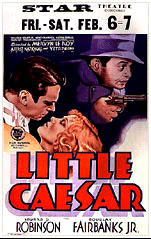 criminal who was vicious,
unremorseful and deadly, with not one redeeming feature in his whole
make-up.
The
famous last lines as Edward. G falls to the floor riddled with bullets
have gone down in movie history and say it all about the character he
plays. criminal who was vicious,
unremorseful and deadly, with not one redeeming feature in his whole
make-up.
The
famous last lines as Edward. G falls to the floor riddled with bullets
have gone down in movie history and say it all about the character he
plays.
" Mother of Mercy, Is this the end for Rico ?"
Scarface
{ 1932
}
By this time gangster movies were big business at the box office and
everyone was jumping on the bandwagon, prompting a flurry of good ,bad or
indifferent films of the genre. Scarface
produced by Howard Hughes and directed by Howard Hawks starred Paul Muni in
the title role and could hardly deny that it was based on the Al Capone story.
Legend has it that there were several visits from Capone’s henchmen
to ensure that their boss had a fair deal and the rushes were shown to Capone
himself for his approval.
Although the media may have had good reason to call Capone the fearsome “
Scarface” his close associates had nicknamed him “ Snorky” but were
careful not to use it in his presence --on the face of it a piece of trivial
information but it does graphically illustrate just how influential and
manipulative the media can be.
G-Me n
{ 1935 } n
{ 1935 }
Up to this point, crime movies had depicted the lurid side of
gangsterism mainly just to draw in the crowds but as the same plots came
to be rehashed time and time again screenwriters realised that audiences
would soon tire of the same worn clichés. In G-Men, William Keighley had
the best of both worlds when he directed James Cagney firstly in his usual
bad-guy role and then in a poacher-turned-gamekeeper scenario had him as a
fledgling F.B.I. agent.
This was a smart move on the director's part because J.Edgar.Hoover had by
this time made himself into the scourge of criminals throughout America
and the well- publicised exploits of his agents had turned them into
national heroes. The legend had been further enhanced from an unusual
source ---- Machine Gun Kelly had been cornered by F.B.I. agents and
throwing down his gun he had yelled " Don't shoot G-Man !" The
name stuck and agents were ever after known as G-Men [ government men}.
Yet again, famous events were incorporated into a fictional story. This
time, Keighley depicted the famous shoot-out at Bohemia Lodge when John
Dillinger, Babyface Nelson and Pretty Boy Floyd and others were surrounded
and in the middle of the night the F.B.I. managed to allow every single
one of them to escape. But Keighley's G-Men were far more astute and shot
the lot of them.
Angels
With Dirty Faces {
1938 } by Michael Curtiz, is arguably Cagney's most memorable film in the
gangster genre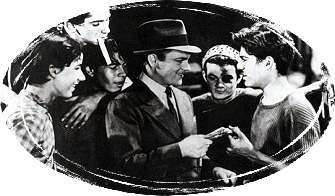 possibly because it was the first appearance of The Dead
End Kids who became instantly popular and later metamorphosed into the
Bowery Boys. The story is transparently the struggle between Good as
represented by Pat O'Brie possibly because it was the first appearance of The Dead
End Kids who became instantly popular and later metamorphosed into the
Bowery Boys. The story is transparently the struggle between Good as
represented by Pat O'Brie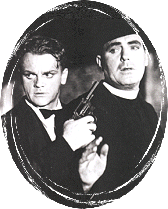 n as the parish Priest and Evil as portrayed by
James Cagney in the role of Rocky Sullivan. The neighbourhood kids idolise
Rocky for his toughness and resilience even if he is drawn to a life of
crime. Although the boys respect the priest they are resistant to his
attempts to get them away from Rockie's pervasive influence { shades of a
Bronx Tale here }. n as the parish Priest and Evil as portrayed by
James Cagney in the role of Rocky Sullivan. The neighbourhood kids idolise
Rocky for his toughness and resilience even if he is drawn to a life of
crime. Although the boys respect the priest they are resistant to his
attempts to get them away from Rockie's pervasive influence { shades of a
Bronx Tale here }.
The struggle reaches a climax when Rocky is sentenced to the electric
chair and in a climactic epiphany and persuaded by the Priest he goes to
his death, kicking and screaming. It is of course all an act and his
selfless performance shatters completely all the romantic illusions the
boys had about his way of life.
Leo Gorcey and Huntz Hall { Bowery Boys } were both brought up in the
parts of New York portrayed in the film and in interviews, both stated
that the film was an accurate portrayal of life on the streets. They said
that squalor was commonplace in the slums and rickets and tuberculosis
were endemic. As a result, it was common for boys to admire hoodlums for
pulling themselves out of such poverty and they took every chance they
could to emulate their heroes.
The
Roaring Twenties {
1939 } It was almost obligatory to have plenty of gun-play in a gangster
film and Raoul Walsh made sure that this film wasn't lacking in that
department but at the same time he provided a thoughtful and complex plot.
With Cagney and Bogart playing opposite each other there was little chance
of a flop and neither disappointed. Friends and comrades in arms during
the First World War the plot has the pair returning to civilian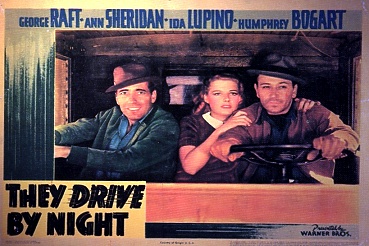 life where
far from being lionised as heroes the world has passed them by.
Bootlegging becomes an appealing option and the two friends embark on a
life of crime. The differences between the pair become apparent as the
film goes on with the major schism being that Cagney is breaking the law
reluctantly and of necessity while Bogart relishes the life and all that
goes with it. Walsh makes sure there's a love interest and the evolution
of the gangster film can be seen clearly. life where
far from being lionised as heroes the world has passed them by.
Bootlegging becomes an appealing option and the two friends embark on a
life of crime. The differences between the pair become apparent as the
film goes on with the major schism being that Cagney is breaking the law
reluctantly and of necessity while Bogart relishes the life and all that
goes with it. Walsh makes sure there's a love interest and the evolution
of the gangster film can be seen clearly.
Gangster films
were money-spinners and numbers of them were churned out in the wake of
the success of the first ones made. Many of them were B pictures with
little known actors and forgettable plots while others might have had poor
storylines but starring the likes of Bogart enhanced them accordingly.
Bogart was joined by others such as George Raft whose performances could
never be lacking in authenticity due to his well- known connections to the
underworld. 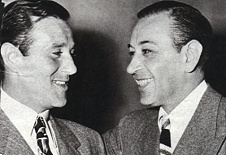 Occasionally, the studios would hedge their bets and throw a
whole host of stars into a movie automatically guaranteeing success. Occasionally, the studios would hedge their bets and throw a
whole host of stars into a movie automatically guaranteeing success.
The Twenties and Thirties in America were two decades of laissez-faire
which with a little imagination could be compared to the Belle-Epoque in
Paris. If nothing else, both eras hold a certain warm feeling of nostalgia
even for those who were born decades afterwards. Part of the nostalgia is
of course the black and white movies and not least the gangster films but
gradually the era began to pass into history. The number of crime movies
never stopped completely but slowed down accordingly and attempted more
thoughtful plots.
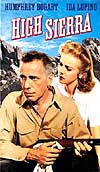
High Sierra
{ 1941 }
Raoul Walsh directed a screenplay by John Huston in which Humphrey Bogart
played " Roy " Mad Dog" Earle. Personally, I was never
enamoured of this film and yet another examination of the psyche of a
gunman is a film too many but many people see it as one of Bogie's best.
White Heat {
1949 } was again directed by Raoul Walsh with James Cagney playing Cody
Jarrett, a mother-fixated psychopath. By this time, Walsh had moved so far
into the world of criminal psychology that if there were any Oscars up for
grabs then they would have been awarded by Social Services. Between
blazing machine- guns at one end of the spectrum and criminal persona at
the other gangster films were becoming a little weary. Fortunately, the
era of film noir was upon us.

Frankly, I am
not too sure that I can give a true definition of film noir but I can tell
what it is when I see it. If I was pushed to sum it up into a few short
sentences then I would say that ;
Film noir movies are shadowy, moody tales of an underworld which operates
in seedy, smoke-filled bars and night clubs. A femme fatale with a
superficial hardness hiding an inner fragility is almost obligatory as is
a hard-bitten, down-at-heel anti-hero with a great line in repartee and
skilled in the use of fist and pistol.
Film noir is for me the film version of Black Cat magazine and all it's
other pulp crime mags of the thirties and Casablanca is the archetypal
film noir movie.
The expression is of course French and came about after the Second World
War in Paris when the aprés guerre malaise expressed itself in
"dark" films and an interest in American crime movies of which
they had a five years backlog to catch up on.
The expression film noir is more in use today than it ever was but is
becoming devalued just as other expressions such as "superstar"
or "classic" are becoming devalued by indiscriminate usage.
As time went by, the
production of gangster movies slowed down ---probably having reached
saturation point. Although the producers may have become tired of the same
worn formats, the public were always drawn to gangster movies and when
black and white became colour, the stories became more complex and the
violence became more graphic they remained faithful to the genre. What was
shocking in the 30's was now mundane and new levels of graphic violence
evolved and are still evolving.
The jury is still out as to the effects this has on impressionable minds
but there is no doubt that from my own experience that exposure to extreme
violence on screen has a numbing effect and as time goes by the
unacceptable becomes acceptable. From a personal viewpoint I can accept {
and indeed am required to accept } graphic violence provided it is within
context and if there is an integrity and quality about it then it moves
away from the realms of voyeurism and is therefore,O.K.
It becomes a problem when the violence is gratuitous and there are films
which glorify violence simply because it sells tickets. This sort of movie
is easy to avoid and I make a point of doing so but life is never simple
and there are other factors arising which require consideration.
Quentin Tarantino has produced very few films without violence but such is
his inherent skill as a Director that he has turned it into an art form
and there is no doubt that it has integrity and the quality stands out.
There is a cult following for Tarantino's work and it is worthy of note
that it is not only popular with shall we say the plebeian members of our
society but is fashionable in far more sophisticated circles.
So how do we react to this innovation ? In the same manner in which we
receive artists such as Caravaggio and Gericault ? And if so, then cinema
has certainly been elevated into exalted circles from a most unlikely
source.
Bonnie and Clyde { 1967 }
They're young --- they're in love ----and they kill people.
When Faye
Dunaway as Bonnie and Warren Beatty as Clyde are blown away in a hail of
bullets in the finale to Bonnie and Clyde, it also blew away the stylised
violence common throughout the 30's, 40's and 50's movies as delineated by
the Hayes 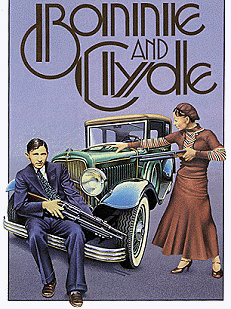 Code.
From then onward, very few crime films were without a serving of
blood-letting of one sort or another and successive films vied with each
other to produce higher quotas of violence, some gratuitous and some not.
Bonnie and Clyde also spawned any number of copycat films, from the 1950'
Gun Crazy----- to
Natural Born Killers. Code.
From then onward, very few crime films were without a serving of
blood-letting of one sort or another and successive films vied with each
other to produce higher quotas of violence, some gratuitous and some not.
Bonnie and Clyde also spawned any number of copycat films, from the 1950'
Gun Crazy----- to
Natural Born Killers.
Although they were active in the same era as Capone, the homicidal pair
were never gangsters in the accepted sense of the word. But just as City
gangsters reacted as they did to their environment, Bonnie and Clyde
reacted in a similar way to theirs. Both were brought up during the
Depression era in Texas but while Bonnie's family were relatively
comfortable, Clyde was brought up in abject poverty. Married at 16,
Bonnie's feckless husband left 3 years later and shortly afterwards she
met Clyde. Bonnie was devoted to her first husband and when he left she
transferred that devotion to Clyde and as she proved many times would do
anything in his cause. Her first dip into the murky waters of law-breaking
came when Clyde was jailed and she smuggled a gun into him in jail to
further an escape attempt. The gun was never used, as a short time
afterwards Clyde was released on parole but she had proven her devotion
which Clyde was never slow to exploit from then onwards.
Bonnie was extremely intelligent and literate and wrote poetry throughout
her short life. She was also the antithesis of a liberated woman in that her
dog-like devotion to her men knew no bounds but as fate would have it that
attraction was reserved for criminals. When she met up with a
career criminal who had no compunction about killing and placed little
value on human life she fell into that way of life just as readily as
she would have followed the path of any man she fell for.
One of her poems, written early in her life with Clyde, gives a very clear
insight into how she romanticized about herself and their life together.
Entitled
Suicide
Sal, it is an entertaining ballad of a young girl who
loves her man through thick and thin. The man in the poem is not named but
is obviously Clyde and Sal paints a picture of someone trying to escape
his poverty-stricken roots but being stopped at every turn by injustice
and prejudice. Sal finds the only way to defend her man is to stand at his
side, gun in hand. The poem is eerily prophetic and explains Bonnie's view
of the world with great clarity.
Their life of crime together began with robberies which quickly escalated
to killings.
One shooting was as good as another and twelve people ended up being
gunned down as the lives of the deadly couple spiralled out of control.
Most of their crimes were carried out in the Depression era mid-west and
to the dirt-poor farming folk they were the embodiment of Jesse James or
Robin Hood striking back at a heartless establishment. Their crimes were
only a generation away from Butch Cassidy and Co and it was easy for the
myth to arise that they were robbing the rich, feeding the poor and
fighting oppression. Several films have been made of the Bonnie and
Clyde story most of which never mention them by name but take elements of
the story and tack them onto other tales. Dorothy Provine was the first to
overtly play the part of Bonnie in
The Bonnie
Parker Story
but the film
departs so much from the truth as to be virtually worthless as a
biography.
Given that in real life, Bonnie Parker and Clyde Barrow lived lives of
such incident, there is very little reason or opportunity to embellish the
true story of Bonnie and Clyde but it took until 1967 to make a reasonably
fair version of the story when Arthur Penn brought it to the screen.
From the moment when Clyde produces his pistol and Bonnie strokes it
lovingly { it would be superfluous to elaborate upon the phall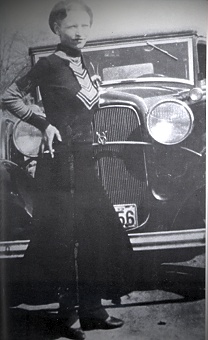 ic symbolism
} the stage is set for Clyde's crazy escapades to be accompanied by an
adoring Bonnie. There's little doubt that Bonnie was bored with her life
as a waitress and she sees Clyde not just as an escape from her ennui but
as a romantic, devil-may-care adventurer which also strongly attracts her
sexually. For her, Clyde is invested in an aura of glamour and she becomes
strongly attached to him from the start. ic symbolism
} the stage is set for Clyde's crazy escapades to be accompanied by an
adoring Bonnie. There's little doubt that Bonnie was bored with her life
as a waitress and she sees Clyde not just as an escape from her ennui but
as a romantic, devil-may-care adventurer which also strongly attracts her
sexually. For her, Clyde is invested in an aura of glamour and she becomes
strongly attached to him from the start.
Clyde initiates Bonnie into the art of bank-robbing and they set off in a
stolen car on the madcap, helter-skelter ride to their brave new world to
the background of Flatt and Scruggs' "Rocky Mountain Breakdown".
Inordinately proud of his prowess as a bank-robber it slowly becomes clear
that Clyde is totally unsuited to his chosen career and the more he works
at it the less they seem to accrue. Not only that, his inadequacies and
lack of any cohesive plans lead to unnecessary shoot-outs with both
civilians and lawmen and their lives become a nomadic flight from the law
and a fruitless search for an elusive pot of gold. Bonnie becomes more
disillusioned by the day but true to form remains constant in her devotion
to Clyde.
Her devotion is tested to the limit when Clyde is found to be less than a
great lover and several disastrous encounters leave her chewing the
pillows in frustration. After one failed attempt at lovemaking she rounds
on Clyde and comments acidly ;
"
Your advertising is just dandy. Folk'd just never guess that you don't
have a thing to sell"
All this seems a little ironic being directed at Warren Beatty of all
people and he must have smiled wryly to himself.
The film makes a great deal of Clyde's apparent lack of libido but it has
no basis in fact and despite everything they remained devoted to each
other throughout. It is possible that the story came about due to Clyde's
preoccupation with guns and cars or it may have emanated from the then new
sport of analysing criminal behaviour in which it was proclaimed that a
psychopathic personality was less highly sexed or it may just have been
that Arthur Penn thought it made the film more interesting.
Michael. J.Pollard joins in the fun as the gang's mechanic. His character
C. W. Moss never existed in real life but in the film is an amalgam of
three of Clyde's criminal associates. Perhaps Penn thought that another
three gang members wouldn't fit in the car or maybe he was just trying to
save money but whichever is the case, M.J. Pollard's simplistic,
come-day-go-day character fits in perfectly.
Gene Hackman as Clyde's brother Buck and Estelle Parsons as his neurotic
wife join the ever-growing circus and with those two additions Bonnie's
disillusionment reaches nadir. Buck's wife has pretensions of being a
middle-class housewife and finds herself in a car with four spoiled
children in the bodies of adults.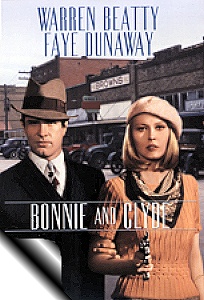
Her feeble attempts to bring some sanity to the proceedings are met with
the same response that any brat would make ---- she's spoiling the fun !
As time goes by the gang's exploits hit the headlines which naturally
embellish their exploits, and a key to Bonnie and Clyde's psychopathic
behaviour is their perceived celebrity status as they gleefully scan the
papers.
Even when Buck is gunned down and Blanche is captured, Bonnie and Clyde
carry on with no perception of the repercussions of their homicidal acts
and a child-like belief that all will be well around the next corner.
Clyde's incompetence as a bank robber is staggering and is only matched by
the incompetence of the lawmen trying to catch them. This and Clyde's
expert driving
{ in real life, Clyde's favourite car was the Ford V8 and he wrote to
Ford to tell them so } along back roads he knows like the back of his
hand, combine to keep the pair enjoying further exploits. But after two
years of mayhem the end was drawing near.
Even now, the ambush at the end has the power to shock as for long minutes
high-powered bullets slam into the two outlaws, their bodies jerking and
twitching obscenely like two marionettes.
The re-enactment of this scene is true to what really happened and the
ambush smacks of Revenge and Retribution with Justice a long way to the
rear.
Arthur Penn's
Bonnie and Clyde omits many details of the story for reasons of film space
but he has picked out the most important events and directed them with
obvious care and a regard to the truth. Much of the dialogue is authentic
and although on the surface Bonnie and Clyde may appear as romanticized
outlaws and the gun-fights are exciting it is a fact that they were both
homicidal killers and Penn has subtly and skillfully shown their lives to
be empty and wasted.Bonnie was 24
years of age when she died and Clyde was 25.
People in the Texas area
still recall them with affection and as defenders of the oppressed.
Bonnie's gravestone reads ;
As the
flowers are made sweeter
By the sunshine and the dew
So this world is made brighter
By the likes of folk like you
Dillinger
{ 1972 }
Director : John Milius
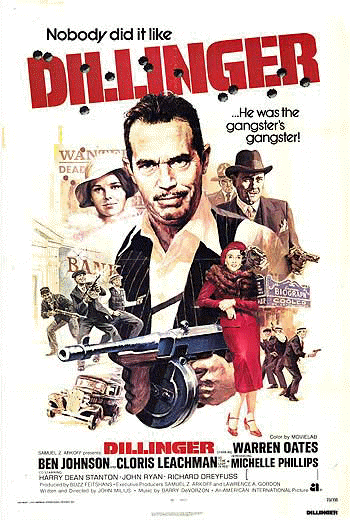 With that devil-may-care smile and
hint of underlying menace Warren Oates makes a perfect Dillinger, the
atmospheric settings evoke the era perfectly and all the ingredients are
in place to make a great film but Dillinger just does not sparkle in the
way that Bonnie and Clyde did. John Dillinger himself was a far more
charismatic character than Clyde and his lifetime of crime contained far
more incident and adventure than Bonnie and Clyde's ever did. There was a
touch of the Douglas Fairbanks and a dab of Errol Flynn about Dillinger
but the film has failed to capture the mercurial and elusive quality of
the man. There was also an aura of farce and black comedy surrounding many
events in his life --- the bank robbery when the gang took so many
hostages that the car would only travel at a crawl and they ended up
dropping them off near to each passenger's home is just one. Dillinger
thought that bank robbery was the highest position a man could aspire to
and despite being around psychopaths like Baby face Nelson and Pretty Boy
Floyd and carrying arsenals of weapons he only ever killed one man, a bank
guard which he regretted and excused as self-defence. With that devil-may-care smile and
hint of underlying menace Warren Oates makes a perfect Dillinger, the
atmospheric settings evoke the era perfectly and all the ingredients are
in place to make a great film but Dillinger just does not sparkle in the
way that Bonnie and Clyde did. John Dillinger himself was a far more
charismatic character than Clyde and his lifetime of crime contained far
more incident and adventure than Bonnie and Clyde's ever did. There was a
touch of the Douglas Fairbanks and a dab of Errol Flynn about Dillinger
but the film has failed to capture the mercurial and elusive quality of
the man. There was also an aura of farce and black comedy surrounding many
events in his life --- the bank robbery when the gang took so many
hostages that the car would only travel at a crawl and they ended up
dropping them off near to each passenger's home is just one. Dillinger
thought that bank robbery was the highest position a man could aspire to
and despite being around psychopaths like Baby face Nelson and Pretty Boy
Floyd and carrying arsenals of weapons he only ever killed one man, a bank
guard which he regretted and excused as self-defence.
Just like the F.B.I. Director
John Milius was never quite able to capture Dillinger.
In many ways, the penal system of the
time made Dillinger into the career criminal that he became by sending him
down for an incredible 10 to 20 years for a bungled teenage robbery. There
he met career bank robbers who tutored him in the ways of robbing banks
and he idolised criminals such as Pierpont and van Meter so much that on his
release Dillinger set about robbing banks to fund their escape. John
Milius has completely omitted any reference to Dillinger's upbringing and
begins with The Kansas City Massacre in which Pretty Boy Floyd and others
attempting to rescue "Jelly Nash" slay several Police officers,
killing Nash in the process. Dillinger played no part in the incident but
the film implies that he did.
There is little continuity in the film and it jumps from incident to
incident in the life of Dillinger making the picture as a whole seem
disjointed and confusing which would be excusable if the facts were
presented logically and honestly but Milius has taken too many liberties
with the truth for his film biography to be taken seriously.
The famous Crown Point incident when Dillinger escapes jail with a wooden
gun is directed quite well but Milius has failed to realise that the
"wooden gun" was a fiction designed to hide the fact that
Dillinger had been smuggled a real gun. Prior to Dillinger's escape there
was a famous incident where the gangster entered the jail as a celebr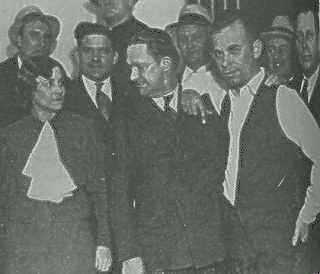 ity
on a par with film stars. Milius has copied the famous picture of
Dillinger leaning on the shoulder of the Public Prosecutor but there is no
mention whatsoever of the scandal that ensued and the careers that were
damaged in the aftermath of this gaffe. ity
on a par with film stars. Milius has copied the famous picture of
Dillinger leaning on the shoulder of the Public Prosecutor but there is no
mention whatsoever of the scandal that ensued and the careers that were
damaged in the aftermath of this gaffe.
Little Bohemia was and is a country lodge on the Canadian border where
Dillinger and his gang hid out when things became too hot. When the gang
were betrayed the F.B.I. had the perfect opportunity to capture the whole
gang and their girl-friends in one fell swoop but despite the lodge being
surrounded on three sides the whole gang slipped away along the lake to
the rear of the building. In reality the incident was a dêbacle and an
embarrassment to the F.B.I. but Milius could not resist the opportunity to
present the event as a massive gun battle { in which Pretty Boy Floyd
takes part although he was never present---neither was Youngblood }
culminating in a running battle along country roads. Pierpont is shot down
on a bridge and tumbles into the river but this is fictional and in real
life he ended up in the electric chair.
Although some of the character parts are
excellent such as Harry Dean Stanton as HomerVan Meter and Steve Kanaly as
Pretty Boy Floyd , Richard Dreyfuss as the vicious and unpredictable Baby
Face Nelson just does not come off while Geoffrey Lewis as Harry Pierpont
is hardly noticeable when in fact he was a major player in the life of
Dillinger.
The biggest disappointment of all is the casting of Ben Johnson as Melvin
Purvis and this is the only film I can recall that I have not enjoyed
watching this actor. Johnson's Purvis is so infuriatingly smug and self-satisfied
that Dillinger and his pals come over as self-effacing. Not only
that, according to Milius, Purvis shot down single-handed every single
criminal on the files of the F.B.I. while the rest of the G-Men were just
on hand to light his cigars. There are many good things to like about this
film but the portrayal of Purvis is not one of them.
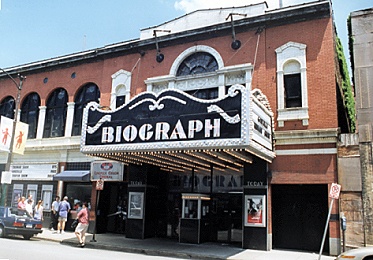
Overall, John Milius's Dillinger is
enjoyable and exciting but falls far short of being great. It is a shame
really but for every historically accurate portrayal of events there
follows some
fictional incident such as the death of Van Meter who was shot down but
not by vigilantes as in the film. If you don't know the true story then
perhaps it doesn't matter or on the other hand perhaps it matters even
more.
The finale when Dillinger is shot
down outside the Biograph cinema is well done even mentioning that
Manhattan Melodrama was showing and the little touch where a lady dips her
skirt in Dillingers blood is true. This scene shows clearly that
exciting
and
authentic
can get along quite well.
The Godfather
{
1972 }
Director : Francis Ford Coppola
After the novel by Mario Puzo
It's difficult to
believe that it is all of 35 years since
The Godfather
was released and
immediately entered into the pantheon of the greatest movies of all time.
It was inspired by Mario Puzo's novel and he never again wrote anything
which came close to the quality of that first book but it was enough for
Francis Ford Coppola to direct a cinematic masterpiece.
There are not enough superlatives to describe the excellence of this film
---it is a feast of great acting and superb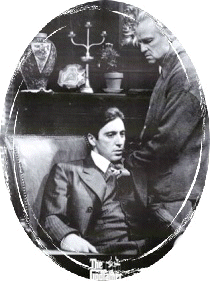 storytelling brought together with the subtle and delicate touch of a
great director. Add to this the haunting theme music which is consistent
with every mood throughout the film and lingers for a very long time
afterwards, and you have quite simply the finest film of its kind.
storytelling brought together with the subtle and delicate touch of a
great director. Add to this the haunting theme music which is consistent
with every mood throughout the film and lingers for a very long time
afterwards, and you have quite simply the finest film of its kind.
The story of life, love and death among the Italian crime families is one
that is deeply ingrained in the American psyche and a vital part in the
great immigration saga. Stripped of all other elements, it is at the core
the story of Sicilian clans transposed to the New World bringing with them
all the customs and mores of their 2000 year history and having no
compunction whatsoever to compromise or adapt to their new surroundings.
The Corleone family business is crime and Michael Corleone { Al Pacino }
plays little part in those activities until his father Vito { Marlon
Brando } is gunned down. His honour forces him to seek revenge and when he
delivers retribution with the slaying of his father's enemies then he is
at once forced to take the first steps upon the long, lonely road that his
father trod a generation previously. It is a road which will ultimately
lead him to be his father's successor as The Godfather. Michael accepts
the inevitability of his fate in the belief that he can be the protector
of his family.
Godfather 11
Is for many people even better than its predecessor but it could never be
that despite being an excellent film in its own right.
As Michael lives out his tenure as Godfather the film takes in many of the
major crime incidents of the era ---- the Nevada casinos, the Havana
episode, the gang wars, the Kefauver Committee ---and parodies many of the
crime lords who are easily recognisable. But Michael finds that the
passing of the years have made his position more precarious than his
father's ever was ---it would have been unthinkable for Vito's wife to
have had an abortion with or without his consent and even more unthinkable
for her to think of leaving. Michael's whole raison d'être and the
reason that he reluctantly shouldered his onerous responsibilities were
for the well-being of his family and Kay's abortion and desertion are a
knife in the heart. Fredo's betrayal leads him to the ultimate irony of
ordering the murder of his brother and as Michael is forced into a
ruthlessness he never wanted so his bitterness increases proportionately.
While Michael is hoeing a very hard row, the story is interspersed with
flashbacks to the early life of the young Vito{
Robert de Niro } and how he came to rule the Corleone family. The
immigration scenes as the ship moves past The Statue of Liberty and onto
Ellis Island are particularly evocative and we are so drawn into Vito's
lifestory that it comes as a shock to suddenly return to Michael's
problems. And then the reverse is also true and each story of father and
son becomes something of a cliffhanger in a film which is a worthy
successor to one of the all-time greats.
Godfather 111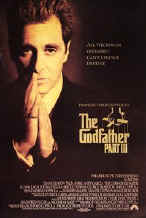
And Michael has
grown into a complete facsimile of his father --- an ageing Don deeply
immersed in a life of crime and intrigue that he tried so hard to avoid.
His attempts to legitimise his " business" and turn his family
from the illegalities of the past have failed. Following Kay's desertion
and Fredo's betrayal further Mafia wars have caused the death of his
daughter in the crossfire, underlining further his impotence and inability
to keep them from harm.
It has to be said that Godfather 111 does not have the cachet of the first
two films but taken as a whole the Trilogy is a brilliant chronicle of a
Darwinian struggle for survival in the urban jungle and the tragedy of a
man thrust into a role he never wanted and unable to prevent the
destruction of all those he ever loved.
The patriarch Vito, long-suffering Michael, tempestuous Sonny and weak
Fredo, aided by the consiglieri and scandalised by the amoral Connie make
up the Corleone family. The cadaverous Tessio, Clemenza who hid the
gun and the not too bright Luca Brazzi { but don't say I said so } faced
off with bad-cop Captain McCluskey and Virgil Sollozzo not to mention
Barzini and the devious Hyman Roth and finally poor Kay who never knew
what she was getting into. I got to know them all quite well in the hours
that I spent in their company.
Once Upon a Time in America
{ 1984 }
Director : Sergio Leone
The
opening 20 minutes of Sergio Leone's
Once
Upon a Time in America
asks some
intriguing questions --- who are a gang of hoodlums hunting so
relentlessly and why and what is the mystery of the safety deposit box
? As " Noodles" Aaronsen
{
Robert de Niro } falls into an opium-induced dream it is a further four
hours before we find out.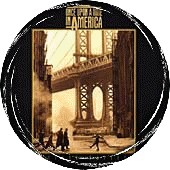
Noodles' dream takes us back to the turn of the century where we first
become acquainted with the Jewish gangsters who dominate the film as they
are growing up together on the streets of New York. The long
sequence is arguably the best part of the film as Leone takes us back to a
sepia-coloured New York of Jewish immigrants struggling to survive in the
mean streets and the seething tenements.
Up to this point the film is easy to follow but as the transition is made
from the young boys into adults, the many flashbacks which are a feature
of the film begin, and as they become more frequent the continuity is
completely lost in a confusing welter of time lapses from the 20's to the
30's and on to the 60's and back again in no particular order.
Leone
has always has a penchant for making his characters interesting but rarely
loveable and as we get to know the gang more intimately it's evident that
his likeable, street-wise urchins have grown into a thoroughly unpleasant
and unscrupulous gang of villains who would have been quite at home in a
spaghetti western. James Woods as Max Bercovicz vies with Noodles
for the leadership of the gang and in a particularly harrowing scene
tacitly encourages the rape of his future girl-friend Carol, played by
Tuesday Weld. If there remains a lingering nostalgia for their sepia
boyhood days it is completely dispelled in this one scene which is a
totally superfluous addition to the screenplay and is as unnecessary as it
is unpleasant and as such can only be described as gratuitous. The scenes
where the gang swap the babies around in the hospital is also shocking and
made more distasteful by Leone's attempt to inject some black humour into
the event.
Ennio Morricone's background music is at times overly sentimental and
slushy and more in keeping with some romantic weepie than a gangster movie
and is played in the background during Noodle's romance with Deborah {
Elizabeth Gelly }. Noodles has hired an orchestra and a restaurant
for his assignation with the delicious Deborah who he has loved since
childhood and you could be excused for thinking we had stepped into a Fred
Astaire as they waltz to the strings and canoodle in soft-focus
candlelight. As Noodles takes her home in the early hours he
suddenly and unexpectedly brutally rapes her in the back of the
chauffeur-driven car. The scene is long and graphic and in this
instance can be construed as necessary to the plot and a pivotal part of
their relationship but again there remains a suggestion that it could have
been gratuitous and hardly endears us to Noodles.
The epic eventually draws to its conclusion which is as confusing as the
rest of the film and you can either accept Max's version of events or that
of Noodles--- I'm not quite sure who I believe. But Leone is not
content to leave things there and in a surreal scene he implies that Max
commits suicide by jumping into a garbage-grinder.
Taken as a whole, the film is overlong, confusing and enigmatic -----
never more so than the final scene when Noodles puffs on an opium-pipe and
grins into the camera suggesting that the whole thing was a dream ?
In the final analysis, Sergio Leone's rambling story is never less
than compelling but is too self-indulgent and confusing to be the
masterpiece that he envisaged.
Goodfellas {
1990 }
Director : Martin Scorsese
From a book by Nicholas Pileggi
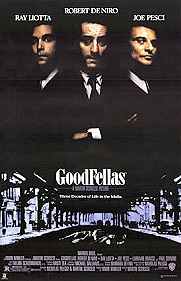 Based
on a true story, Goodfellas chronicles the life of crime of Henry Hill as
told in the conversational voice-over by Ray Liotta throughout the film.
Usually, just a directing device, in this instance the chatty voice-over
turns out to be essential in translating the arcane mores governing the
actions of many of the characters and at the same time intimating that
Henry is telling his tale to us the audience directly. Based
on a true story, Goodfellas chronicles the life of crime of Henry Hill as
told in the conversational voice-over by Ray Liotta throughout the film.
Usually, just a directing device, in this instance the chatty voice-over
turns out to be essential in translating the arcane mores governing the
actions of many of the characters and at the same time intimating that
Henry is telling his tale to us the audience directly.
The fledgling hoodlums of Martin Scorsese's semi-autobiographical Mean
Streets could very well have grown into the gangsters depicted in
Goodfellas and Scorsese would have quite easily identified with the
teenage Henry Hill.
Henry's teenage adulation of the gang across the street is understandable
given the normal teenager's obsession with needing to belong but in this
case it leads him down a road from which there is no return. Not that
Henry would have cared ---- at the time the allure of the gangsters was
overwhelming.
Starting as a youthful errand boy, as the years go by Henry becomes an
integral part of the crime-family with theft and random violence an
accepted part of his chosen vocation. The film clearly illustrates the
almost monastic affinity of a Mafia family and its complete disregard and
disdain of anything or anyone outside the brotherhood. The whole extended
family is a secret society, a closed order with its own customs and
practices and devoted only to the well-being of its members.
Henry has grown up alongside Tommy DeVito, played by Joe Pesci. Tommy has
taken "vicious" and "sadistic" to be complimentary and
provoked by the least little thing or the most innocuous remark,
throughout the film his volatile and erratic nature inevitably leads to
butchery and bloodshed, savage beyond all reason.
Forever holding court of the "laugh when I laugh" kind and
always surrounded by a sycophantic audience, on one occasion Tommy is
recounting one of his sadistic tales of black humour when Henry laughs too
loud and too long. You can hear a pin-drop when Tommy asks him "
What's so funny ?" and "Are you laughing at me ? " You
think I'm a funny guy"? As Tommy pursues his interrogation Henry
becomes more and more alarmed and as the tension is stretched to breaking
point Tommy breaks the spell inferring that it was a wind-up all the time.
The relief around the table and in particular by Henry is palpable. The
film is worth seeing for this scene alone and when I first saw it I knew
right away it would be an immediate entry into my notebook of great screen
moments to be re-enacted over again after a few with pints ensuring of
course that I was with a few friends who would know what I was on about.
While Joe Pesci's Tommy has a great time interpreting how Caligula would
have turned out if he had been born in the Bronx, Robert de Niro's Jimmy
Conway is nowhere near as overtly violent. But beneath his urbane persona
lurks a manipulative and ambitious spirit and he is no less murderous than
Tommy whenever the need arises. Paul Sorvino's Paulie the benign head of
the family, exemplifies an old-school capo devoted to making money and
keeping a low profile. His inability to control his violent underlings is
eventually a major factor in the downfall of them all.
Tommy, Jimmy and Henry along with the whole of their Mafia family enjoy a
film star celebrity and are fêted and fussed over wherever they go, never
knowing or caring that their celebrity is in truth notoriety and their
fame is really fear.
It is very apparent that Martin Scorsese has no respect for any of the
women associated with the gangsters---- from Tommy's doting mother to
Henry's hysterical wife and on to the mink-clad and foul-mouthed harpies
believing themselves to be supportive wives and mothers to the hoodlums
-----Scorsese damns them all.
In the male-dominated society that they are part of the women play out
their roles of true domesticates while indulging themselves in orgies of
kitsch and bad taste with their men's ill-gotten gains.
At the high point of Henry Hill's career in crime, given his celebrity
status, the tacit approval of the police and the illusion of domestic
bliss there is a sense that what the gangsters are doing is not criminal
at all. They have almost come to believe that their activities are not
only acceptable but even laudable and such is the strength of the family
that they are immune from any outside influences.
There is some truth in their arrogance because their house of cards falls
down not by police investigations but by their own greed and paranoia à
la Dobbsie { see Treasure of the Sierra Madre
} as they turn on each other
in a frenzy of killing.
Goodfellas is one of the finest gangster movies ever made and contrary to
glorifying crime it is in its way a damning indictment of a self-serving
and nihilistic way of life.
The portrayal of the Byzantine workings of a crime family is explicit and
we are only left to wonder why Henry Hill ever wanted to join such a
dysfunctional family at all.
Casino
{1995 }
Director : Martin Scorsese
Martin Scorsese
has taken so many elements from Goodfellas and grafted them onto Casino
that if you had not seen the film you would be excused for believing that
it would be another version of Goodfellas in a different guise. Firstly,
there is the voice-over commentary which in this case has a variation in
that several of the characters relate their versions of the true story.
There is Joe Pesci reprising his role in Goodfellas as the even more
sadistic Nicky Santino. Sometimes in uncontrollable rages, and occasionally chillingly cheerful, Nicky will
indulge in the most horrific torture and then return home to dote on his
family as if it were just another day at the office. There is even the
doting Jewish mother, clicking and tutting as her loving son rages and
curses against his enemies. This theme of days of gangsterdom and evenings
of what is perceived to be domestic bliss run through all of Scorsese's
films. There are many other similarities but the most compelling is the
enduring morality tale of gangsters rising to the peak of their profession
and the inevitability of being brought down by their own greed.
uncontrollable rages, and occasionally chillingly cheerful, Nicky will
indulge in the most horrific torture and then return home to dote on his
family as if it were just another day at the office. There is even the
doting Jewish mother, clicking and tutting as her loving son rages and
curses against his enemies. This theme of days of gangsterdom and evenings
of what is perceived to be domestic bliss run through all of Scorsese's
films. There are many other similarities but the most compelling is the
enduring morality tale of gangsters rising to the peak of their profession
and the inevitability of being brought down by their own greed.
Despite all these things or perhaps because of them Casino rivals
Goodfellas as one of the great gangster movies and it is difficult to
choose between them. Robert de Niro's Sam "Ace" Rothstein is
basically a weak character who would never have been nothing but a petty
crook if it were not for his exceptional talents in any matters pertaining
to gambling. Manipulated by the mob, Ace is quite happy in his role as the
manager of the Las Vegas Tangiers, as he quietly stashes away his share of
the spoils and perhaps his idyll would have continued ad infinitum if not
for three things: firstly, his relationship with Nicky who sees himself as
his minder and friend which is akin to living with a rabid pit-bull
terrier, secondly his deplorable management skills and not least his
dog-like devotion to the stunningly beautiful Ginger { Sharon Stone in her
finest role }. Ace is fully aware
of Ginger's track record as a hustler and hooker and foolishly believes
that he can convert her into a domestic goddess. Unfortunately for Ace,
Ginger's finger is never far from the self-destruct button as in the midst
of wealth and luxury she pines for her erstwhile pimp
{ James Woods } and
her life slowly disintegrates. In the meanwhile, Nicky, by now completely
out of control, is carrying out a reign of terror on everyone within
reach. All this combined with several appalling managerial decisions
brings Ace's world crashing down and just like Henry Hill he finds not
only his lifestyle at an end but possibly his life also.
Another among many of Martin Scorsese's enduring and endearing themes
throughout his mob movies is that all of his gangsters have their heyday
but inevitably come to violent ends and Casino remains true to the format.
Neither does Scorsese ever give in to the temptation to glorify his
gangsters and he never deviates from highlighting their sole motivation of
accruing riches as the very thing that brings them to their knees.
In Goodfellas and Casino we have two of the finest mob movies ever made by
a director at the top of his game and if at times the violence is
excessive and we feel slightly voyeuristic for watching there is always
the consolation that evil will reap its reward.
A Bronx Tale
{ 1993 ]
Directed by : Robert de Niro
Unlike many
plays which somehow just don't make the transition from theatre to cinema,
A Bronx Tale translates seamlessly onto the big screen with Robert de Niro
both directing his first film and playing the part of Lorenzo Anello.
Proud of his Sicilian heritage, Lorenzo is a hard-working and honest bus
driver trying to maintain a family in a tough neighbourhood while resisting
the temptations o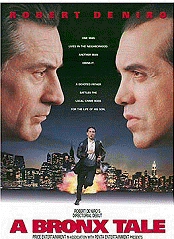 f
easy money. His life becomes proportionately more difficult when Calogero,
his son aged 9 at the time, witnesses a shooting and refuses to divulge to
the police who did it. Sonny { Chazz Palminteri
} is the man who did the shooting and he is a Mafioso who has his
headquarters in the bar down the street. Sonny takes Calogero under his
wing and Calogero in his turn, idolises the charismatic gangster. As
Calogero grows into a young man his life is characterised by the constant
struggle for his soul between his father and Sonny with both men having an
immense influence over him. f
easy money. His life becomes proportionately more difficult when Calogero,
his son aged 9 at the time, witnesses a shooting and refuses to divulge to
the police who did it. Sonny { Chazz Palminteri
} is the man who did the shooting and he is a Mafioso who has his
headquarters in the bar down the street. Sonny takes Calogero under his
wing and Calogero in his turn, idolises the charismatic gangster. As
Calogero grows into a young man his life is characterised by the constant
struggle for his soul between his father and Sonny with both men having an
immense influence over him.
Chazz Palminteri is credited with writing the original theatre play and
Robert de Niro has turned it into a superbly observed movie which brings
alive the mean streets of the Bronx during the 60's to a background of
some great music. Characterisation is minutely studied and it's easy to
identify with the denizens of the neighbourhood as they live their lives
amidst racism, violence and gangsterism. As Lorenzo tries to steer his son
away from the siren sound of Sonny's way of life his twin themes
throughout are that :
Lorenzo as a father loves and is loved while Sonny is feared. And
The saddest thing in life is to waste your talent.
In the final analysis it is Sonny himself who saves Calogero and pushes
him away from a life of crime.
Great film with a cast who look like they lived on the same streets all
their lives and a surprise visit by Joe Pesci as an added treat.
The
Road to Perdition {
2002 }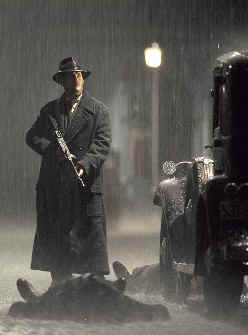
Director: Sam Mendes
In the on-going quest for
different storylines Mendes has borrowed from the graphic novel by Max
Allan Collins and Richard Piers Rayner and turned it into a confused and
confusing saga of Irish gangsters in the 30's. Paul Newman as John
Rooney, patriarchal crimelord, just does not translate at all while Daniel
Craig as his sadistic son reincarnates the Burl Ives/Chuck Connors, Alex
Nicol/ Donald Crisp syndromes in The Big Country and Man from Laramie
respectively. Mike Sullivan is a monosyllabic, Irish hitman as
played by Tom Hanks in a part which just does not suit his acting style at
all while poor old Jude Law looks more like a demented Stan Laurel than a
gunman and as an exercise in miscasting the film is exemplary. Gloomy and depressing most of the time with little excitement and
ludicrous storyline, there are plenty of bullet holes in Perdition but far
more holes in the plot.
Mendes had a lot to live up to but he never came
close with this effort so we must await the time when someone else picks
up the baton. Crime is one area that Steven Spielberg has not yet
ventured to film ---it would be intriguing to see the results.
There's one thing that is recurrent
throughout the gangster movies and that is that throughout most of the
films either the director or the actors or both have actually lived in and
among the locations depicted and as such they are in effect valuable
historical documents of not only events but streets and areas of places
they have lived. Chazz Palminteri actually witnessed a shooting when
he was a child. Later in life he made the incident into a monologue
which evolved into a play and then into
A Bronx Tale. I suspect that
many mob movies have had the same sort of beginnings.
I suppose in some
quarters it would be a major omission to ignore the gangster films of Quentin
Tarantino and it has to be said that Reservoir Dogs
and Pulp Fiction are spoken of with
whispered reverence among Tarantino fans. The very name of Tarantino
invokes adulation akin to adulation and it will therefore be heretical to
state that both films are vastly over-rated orgies of gratuitous violence but
despite A-list stars and good direction that's exactly what they are --worse
still, they are boring. Tarantino never fails to put plot and storyline
secondary to evermore ingenious methods of shocking his audience.
Kill Bill is Tarantino's magnum opus
where all the previous elements employed come together in a great feast of
bloodletting. There is however a marked difference in this film and the
others previously mentioned and that is the fact that unlike those others Kill
Bill is surreal ---- it is a carefully choreographed ballet of
stylized violence which is not of this world and for this reason alone I find
this film acceptable and likeable. Comic-book violence, Manga and
Martial-arts come together to create a dance of death where fountains of
blood spray, heads roll and swords flash to a background of eclectic music and
I have even come to like the film but his gangster films are not in the same
class.

|


